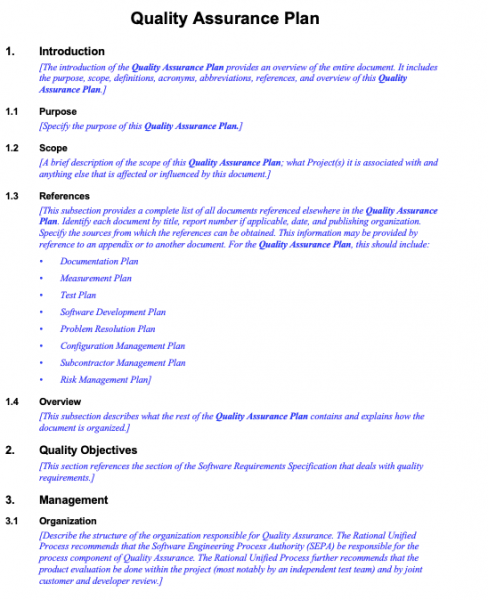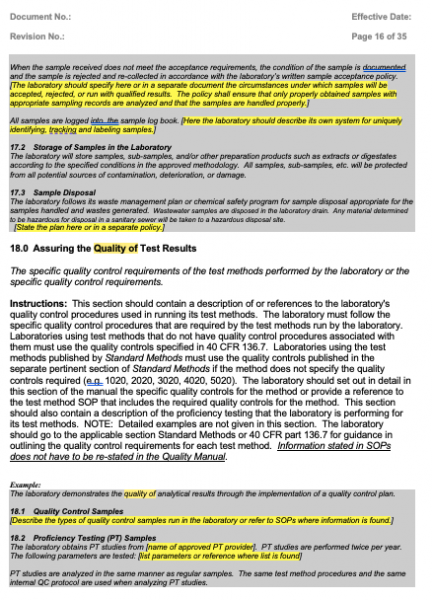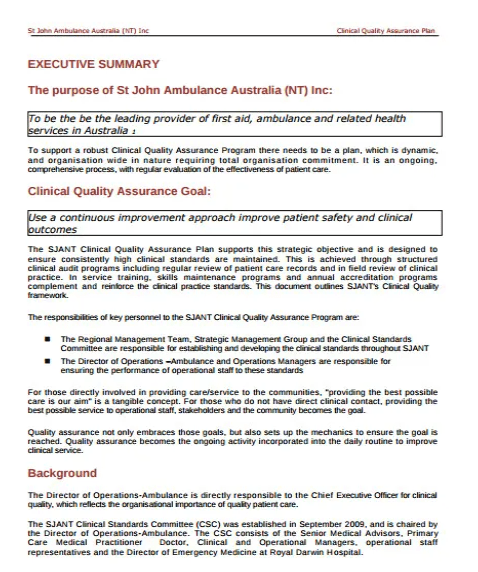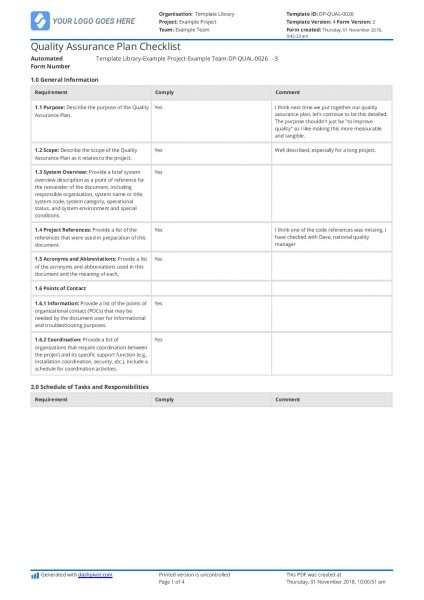A quality assurance plan template is a document that outlines the processes and procedures that will be followed to ensure that the final product meets the required quality standards. The plan should be developed during the planning phase of the project and should be updated throughout the project as needed.
The quality assurance plan should detail how quality will be measured, what methods will be used to check for compliance, and who will be responsible for carrying out the quality assurance activities.
Product quality assurance is a process that provides confidence that a product or service will meet the needs of the customer and the objectives of the organization.
- Importance of quality assurance plan
- Quality Assurance Plan Word
- How to implement a quality assurance plan
- Tips for effective implementation of a quality assurance plan
- Quality Assurance Plan Template PDF
- Writing an effective quality assurance plan
- Benefits of a quality assurance plan
- Project Quality Management Beginners Guide
The main goal of QA is to prevent defects from reaching the customer or to prevent mistakes in the product by implementing a series of preventive measures.
These measures can include process control, acceptance sampling, control charts, and product quality control.
The quality assurance plan should be created at the beginning of the project, and it should be followed throughout the entire project. This plan typically includes various quality control measures, such as inspections, testing, and audits.
These measures are designed to identify and correct any errors or defects in the deliverables before they are released to the client. It should be reviewed and updated regularly to ensure that it remains relevant and effective.
Importance of quality assurance plan
The quality assurance plan should detail how quality will be measured, what methods will be used to check for compliance, and who will be responsible for carrying out the quality assurance activities.
It is important to develop a QA plan before any work begins. This will ensure that all parties involved understand the expectations and requirements. It also allows for any potential problems to be identified and addressed early on.
It will also provide a roadmap for the team to follow during the development process. Without a quality assurance plan, it would be difficult to ensure that a project meets all quality standards.
Overall, a quality assurance plan is an important part of any business. It helps ensure that products and services are of the highest quality and meet customer expectations. Some of the most important components and key questions to ask yourself are listed below:
- Quality objectives: What are the goals that the company wants to achieve with its quality assurance efforts?
- Quality standards: What standards will be used to measure whether or not the company’s products or services are meeting the quality objectives?
- Quality control procedures: What procedures will be put in place to test and monitor the quality of the company’s products or services?
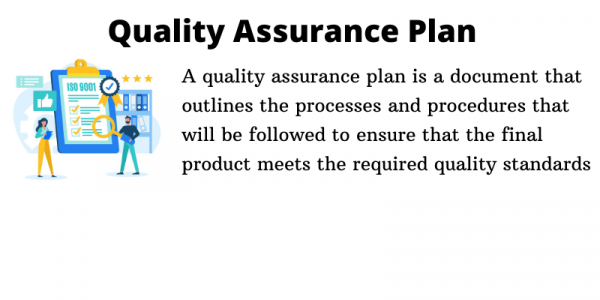
Quality Assurance Plan Word
It is important to develop a QA plan before any work begins. This will ensure that all parties involved understand the expectations and requirements.
Project managers can use quality assurance plans to help them ensure that their projects meet all of the necessary requirements.
A Quality assurance plan should identify all of the potential risks and problems that could occur during a project, and it should outline how these risks and problems will be mitigated. By having this plan in place, project managers can rest assured that their projects are more likely to be successful.
How to implement a quality assurance plan
Once the quality assurance plan is in place, the project manager can begin to implement it. This typically involves conducting quality assurance activities at various stages of the project. Quality assurance activities may be conducted during the project planning stage, during project execution, and after project completion.
Once you have the tools and methods in place, you will need to train your team on how to use them. This is an important step to ensure that everyone is on the same page. By following these steps, you can create a quality assurance plan that will help your project run smoothly and meet all of the necessary quality standards.
Identify the quality standards
First, you will need to identify the quality standards that your project must meet. You will need to identify the objectives of the quality assurance plan. What are you trying to achieve with this plan? Once you know the objectives, you can develop specific goals and objectives that need to be met. The plan should identify the people, processes, and tools that will be used to carry out the QA activities
Test and verify standards
You will need to create a process for testing and verifying that these standards are met. You will need to select the right tools and methods for your quality assurance plan. There are many different options available, so it is important to choose the ones that will work best for your project.
Address quality issue
You will need to create a plan for addressing any quality issues that are discovered. Once you have the tools and methods in place, you will need to train your team on how to use them. This is an important step to ensure that everyone is on the same page to succeed in the project you are working on.
Tips for effective implementation of a quality assurance plan
Projects can face a number of risks that can jeopardize their successful completion.
In order to mitigate these risks, it is important to have a well-thought-out quality assurance plan in place. This plan should identify the various risks that could impact the project and establish procedures for how to address them. There are a few key components to an effective quality assurance plan:
- Identification of risks: the first step is to identify the risks that could impact the project. This can be done through a variety of techniques, such as a risk analysis.
- Establish procedures: once the risks have been identified, procedures should be put in place for how to address them. These procedures should be clear and concise so that everyone involved knows what needs to be done.
- Plan: Identify the goals and objectives of the quality assurance plan.
- Implement: Put the quality assurance plan into action.
- Monitor: Track the progress of the quality assurance plan and make improvements as needed.
- Evaluate: assess the results of the quality assurance plan and make changes as needed.
Quality Assurance Plan Template PDF
Writing an effective quality assurance plan
The plan should be tailored to the specific needs of the project and should be approved by the project manager before it is put into action. The plan should also include any tools or templates that will be used to support the quality assurance process. The quality assurance plan must follow:
- A description of the quality standards that will be used to measure the project’s progress.
- The methods that will be used to monitor and assess quality.
- It should also identify the roles and responsibilities of the team members in relation to quality assurance. This can be applied to individual software products, as well as to the software development process itself.
This is a document that outlines the steps that will be taken to ensure that a software program meets its intended purpose and does not contain defects. The plan should identify the people, processes, and tools that will be used to carry out the QA activities.
So how do you create a QA plan? Outline the following:
- Define the scope of the project.
- Determine the quality criteria.
- Develop a testing strategy.
Writing a quality assurance plan can be daunting, but it doesn’t have to be.
Benefits of a quality assurance plan
There are many benefits of incorporating a quality assurance plan into your project management strategy. By ensuring that all aspects of your project meet quality standards, you can minimize the risk of costly mistakes and delays as we mentioned. The benefits of a quality assurance plan are numerous.
For example:
Reduced risk of defects: By ensuring that products and services meet the required standards, the risk of defects is reduced.
This can save a lot of time and money in the long run, as well as protect the reputation of the company.
Improved customer satisfaction: When customers know that a product or service has been through a rigorous quality assurance process, they are more likely to be satisfied with it. This can lead to repeat business and positive word-of-mouth in your market or niche. In an overview, a plan can help your project or plan by:
- Avoiding potential project delays or failures
- Identifying potential risks early on
- Reducing the overall cost of the project
- Improving the quality of the project’s deliverables and checking that every detail in deliverables is properly fit for their purpose
By having a plan in place, you can be sure that your project meets all the necessary requirements and standards.
This can save you time and money in the long run, as you will not have to redo work that does not meet the requirements. Additionally, a quality assurance plan can give you peace of mind, knowing that your project is in good hands.
FAQs
What is a Quality Assurance Plan?
A quality assurance plan is a detailed document that describes the process that will be followed to ensure that the final product meets the required standards. It should be designed to control and monitor the quality of the project at all stages, from planning to execution.
When should a Quality Assurance Plan be developed?
The quality assurance plan should be developed early on in the project lifecycle, preferably during the planning stage. This will ensure that all team members are aware of the procedures and processes that need to be followed in order to meet quality standards.
How to create a Quality assurance plan in Project Management?
There are a few key steps to creating a quality assurance plan. First, you will need to identify the quality standards that your project must meet. Next, you will need to create a process for testing and verifying that these standards are met. Finally, you will need to create a plan for addressing any quality issues that are discovered.
What are the benefits of a Quality Assurance Plan in Project Management?
A quality assurance plan can benefit your organization by improving key communication and coordination among team members. It can also provide a systematic approach for tracking and addressing quality issues. Ultimately, using a quality assurance plan can help you deliver a better product or service to your clients or customers.

